Text
Okemah, Oklahoma
What can you say about a small town of about 3,000 people smack dab between Oklahoma City and Tulsa? A lot! Like all things adventurous, you just have to look.
While visiting some family over Labor Day weekend I took the chance to see all I could of this little Podunk paradise between the six or seven stops I made to the local Homeland for more chips, avocados, and beer, and the more I saw, the more charm it seemed to have. Sitting right next to I-40, the town would be hidden if it were not for the three lone water towers that say, “Okemah” and “Home of Woody Guthrie.” Now unless you’re a fan of old school folk music of the 1940′s, don’t feel bad if you don’t know the guy. You probably do, however, know some of his work. Guthrie is famous for writing the patriotic song, “This Land is Made for You and Me” which everyone more than likely learned to sing in kindergarten. If you don’t know what song I’m talking about, get yourself checked out because everyone knows it. Even if you aren’t a fan of folk music, you can’t help but appreciate the fact that a legend in the industry had his humble beginnings rooted in this small town.

If you find yourself passing through, take the time to pay homage to the man himself in the small park on Broadway Street where he is immortalized by a small statue and a mural on the building adjacent to it. It’s also a great spot for pictures!

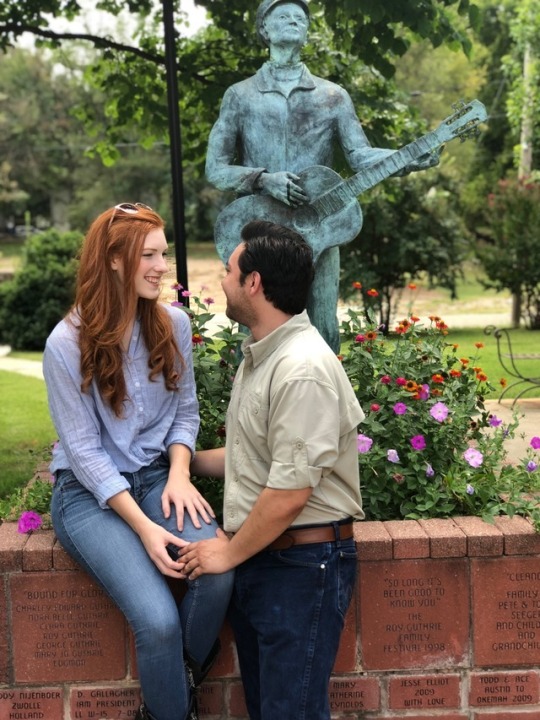
Speaking of Broadway Street, if your looking for a good mix of both history and culture, then look no further than this main street that delivers visitors the mystique of a time long passed and a hopeful future.This asphalt avenue has been the vein that leads through the heart of Okemah since the town’s founding in 1902, five years before Oklahoma became a state. Before I get too far ahead of myself though, here’s a little background of Okemah: when it was founded, it was founded with the intention of being a hub for two major railroads, Fort Smith and Western Railroad and the Ozark and Cherokee Central Railway (later the St. Louis and San Francisco Railway). Only the former actually went through in building a track there though. Okemah is also infamous in being the site near the lynching of Laura Nelson and her son in 1911 over the North Canadian River from a suspension bridge. The photograph taken by George Farnum of the lynching remains to be one of the most famous photos of such an event.
In its heyday, Okemah thrived and its downtown district was filled with different businesses from banks to markets, but when the Great Depression hit, the city suffered and has since had moments of peaks and valleys in its economy. The strike of the Great Recession back in 2008 didn’t help by any means either. The economic struggles of the town is reflected when one drives down Broadway. Brick buildings line the street with spots of businesses throughout a mainly empty corridor of closed down shops with signs in the windows reading “for lease,” or “for sale.” Add a couple fallen structures behind the downtown district and you can’t help but feel saddened by the scene. However, that is not to say there isn’t any life. I recommend taking the time to stroll down the street and discover the little hot spots that remain like the hen house - a family owned restaurant that serves up southern comfort food like no other and makes you feel like you’re home with its retro vibe, huge Coca Cola sign out front and old truck parked in front of the entrance, or if you feel like a pick-me-up, stop inside Sacred Grounds Brew for some of the best coffee you can get in Oklahoma! I would say it’s even better than Starbucks! Now don’t get me wrong, I like Starbucks, but you can’t beat that small town gourmet craftsmanship they got brewing up like in Okemah. If you feel like you need to wind down and relax, visit the Crystal Theater that has a whopping one showroom that can play Avengers: Infinity War as many times as you like because it’s the only thing they got showing until the next big film comes out. From a small boutique and supermarket to a small museum and photography studio, Okemah’s downtown beams with light that looks toward a brighter future for business and commerce.

I know I’ve written quite a bit about downtown, but don’t let that distract you from all else that makes Okemah special. For example, how many of you knew that Okemah, OK was a chosen site for the U.S government to house German POW's during and after WWII? If any of you said yes I wouldn’t know, because this is a post and I can’t see you, so I’m going to write about it anyway! What is now the stadium that houses a baseball field and football field for the Okemah Panthers, the local high school’s athletic teams, was once a prison camp for Nazis and German soldiers! Insane, right? If you walk up to any part of the stadium you’ll be met with depression rock and stone that make up the fortified walls, a building next to it that is near abandoned and looks like something out of Ghost Adventures, and an admission booth that once stood as a guard’s booth in front of the gate that led to the recreation area, now the football field. When I walked the perimeter of the stadium I felt solemn for how eerie the place was but that might have been because it was located on 7th and Eerie street. Get it? EERIE street? Someone queue the *buh dum tsssh.* I was also though struck in awe by what this structure has become seventy years later. If you like WWII or just admire architecture, make sure to come here.




Lastly if you need to cool down (which if you’re in Oklahoma during the summer like I was, you’ll need to) and escape the hustle and bustle of a 3,000 people city, just five miles outside of town is Okemah Lake where you can jetski, swim, or chill lakeside catching some rays. Like the Guthrie statue this is a perfect place for pictures with the family or picnics under the trees, and like all things in Okemah, it has a charm that you can’t help but like and smile to.

You might think, “why and when would I find or go to Okemah, OK?” and the only thing I can respond to that is, why not? Adventure is what you make of it, and no matter where you go, there is always adventure. If you find yourself crossing the plains of Oklahoma, stop and get lost in this tiny town, because you might just have adventure found.

#history#oklahoma#United States#america#old#retro#downtown#war#world war 2#folk#music#statue#art#woody guthrie#family#girlfriend
0 notes
Text
Little Bighorn Battlefield National Monument, Montana, USA
I know, I know, it’s been a while, so let’s get right down to it.
This monument and battlefield stands as an eerie reminder of one of the most infamous battles in American military history. The 7th Cavalry led by Lieutenant Colonel George Armstrong Custer collided with the combined forces of the Lakota, Nothern Cheyenne, and Arapaho led by leaders like Sitting Bull and Crazy Horse on June 25th, 1876 near the Little Bighorn River. Over the course of 24 hours, 268 members of the 7th Cav were killed, including Custer, and 36 Natives (Native deaths vary greatly, going up to as much as 300, but 36 is more agreed upon by historians). The battle is known as a decisive victory for Native Americans over U.S forces during America’s Westward Expansion, but their last major one before the U.S succeeded in taking full control of the area in the latter half of the 19th century. I won’t go into too much detail about the battle itself because that would take more than a blog post to do justice of the event. So instead, I’ll focus on the monument.
Now the biggest attraction of the monument is the infamous “Last Stand Hill” where George Custer was surrounded and fell to Native forces. Because of it’s popularity, the Parks Dept. put their ranger station, museum, and gift shop just a few feet away. I recommend that you stop there in the ranger station first to get all the info about the field and battle before starting your journey. On top of the hill as well is a pillar that lists the names of the fallen for U.S forces, and next to it are their markers - at least the ones who died there on LSH. The battlefield, which is about 1.5 miles wide and 5 miles in length (if you count Garryowen where the first shots occurred), is huge and littered with markers of both sides that give any tourist a solemn feeling of reverence for the events that transpired there. I know it did for me. Take note that no one is buried under their markers. The bodies have been moved to a mass grave that sits below the pillar on LSH.

Though I’m talking a lot about LSH, it isn’t the only thing worth seeing at the monument. As I said, this battlefield is huge. I highly recommend to those who go there to not start at LSH, but stopping at the ranger station, get your info, and drive the road that starts at the station and runs through the battlefield. The road takes you to where the beginning events of the battle occurred and loops you back to LSH. Take your time! From the loop, the road let’s you follow the battle in chronological order, and I promise you, if you’ve done that, not only do you get all the history you’re looking for, but you’ll truly digest the battle in its entirety.
If you’re feeling a little adventurous, park your car at the loop in the parking lot when you get there. You’ll notice another pillar that is dedicated to the men who fell under Major Marcus Reno’s and Captain Frederick Benteen’s command, Custer’s 2nd and 3rd in command, respectively. Next to the pillar are a couple of entrances for tourists to walk and see some of the markers up close as well as the incredibly preserved rifle pits that were dug by cavalrymen bogged down my gunfire from Native forces during the battle. You can almost feel the chaos that was this battle, seeing where men fell and clung to whatever protection they could find as bullets whistled past their heads.
By the time you finally reach LSH again, don’t be surprised if you find yourself in shock and awe of what this battle was, the reasons for it, the repercussions that followed, and feelings of sadness for both sides. Before you head out though, pay homage to the warriors of the U.S and Native forces at their respective memorials just a few feet away from the ranger station; one a wall of valor for Native peoples and their fight to protect their way of life and the other a national cemetery honoring American soldiers who fought in duty of their country from the Indian Wars to Vietnam.
This national monument stands as a reminder to the events that transpired here as I aforementioned, but also as a testament to the struggles, pain, and animosity Natives have for being conquered peoples. So proceed with reverence. It’s a hard look on America’s history of expansion, but a necessary one to know the history of our people and how making a country that spreads from sea to shining sea was possible.







0 notes
Photo

American soldier replaces “Adolf-Hitler-Str.” sign with “Roosevelt Blvd.” in Berlin, Germany, 1945.
via reddit
833 notes
·
View notes
Photo

St. Jean Church in Ephesus City. Saint Jean is 1 of 12 apostles of Jesus who entrusted Virgin Mary to him. St. Jean & Virgin Mary moved from Jerusalem to Ephesus where paganism reigned. St. Jean who visited secretly Virgin Mary every day was buried where this church lacated in today.
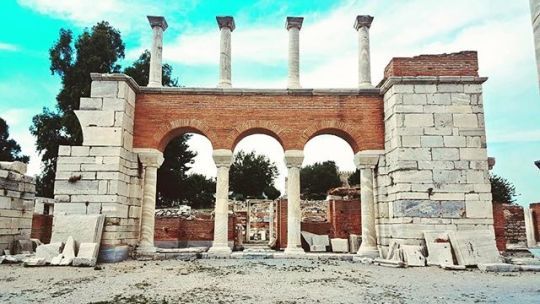
photo by instagram.com/antiquity.times
63 notes
·
View notes
Photo
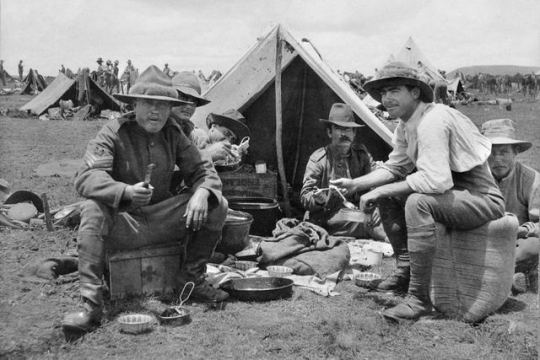
Australian Light Horse cavalry eating breakfast on the veldt. Boer war 1901.
via reddit
Keep reading
202 notes
·
View notes
Text
Garryowen, Montana
Let me start off by saying this town holds a special place in my heart. I had the great fortune of working here in the summer of 2017 at the museum as a summer intern! Booming with a population of one, this small town which consists of a museum, post office, and restaurant lays in the heart of the Crow Reservation in Montana. The complex stands on where the infamous Battle of the Little Bighorn began.
For those who may be unfamiliar, the Battle of the Little Bighorn in brief was a conflict between forces of the U.S 7th Calvary led by Brigadier General George Custer and their Crow allies and the combined forces of the Sioux, Nothern Cheyenne, and Arapaho led by leaders like Sitting Bull and Crazy Horse. The final result was a decisive victory for the combined Native forces and massacre of the 7th Cavalry. (Look out for another post later about the national monument that’ll go into more detail of the battle.)
Now back to Garryowen! The town was named by Buffalo Bill Cody after the Irish drinking song “Garryowen” that was the marching tune of the 7th Cavalry. It still remains to be the 7th’s fighting song to this day! Garryowen’s claim to fame is famous for being the location where the first shots of the battle were fired when Major Marcus Reno failed to charge into the massive combined native village and was forced to retreat. In fact, the residential quarters in the back of the property are the approximate spot where Sioux leader Sitting Bull had his teepee when those shots went off. For those who are traveling on the I-90, this is a must stop shop to get your history fix before seeing the National Monument down the road.
Before you walk in, take some time to honor the fallen by laying down flowers or taking a moment of silence in front of the Tomb of the Unknown Soldier. Dedicated in 1926, exactly 50 years after the battle, General Godfrey and White Bull, who both were present in the battle, met to shake hands and buried the hatchet between the two cultures...literally. Among the many artifacts buried in the tomb to commemorate peace, one was a hatchet that inspired the phrase “bury the hatchet” today!


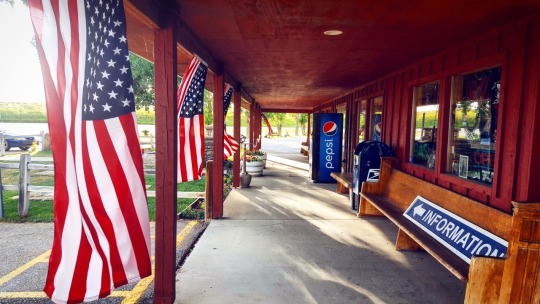
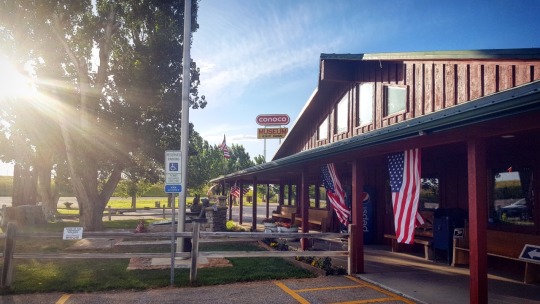




My next piece of advice is to visit the museum inside the complex. In there you can find incredible artifacts that include Tom Custer’s pistol he dropped when killed on Last Stand Hill, Sitting Bull’s death mask, Crow scout White Swan’s rifle used in battle, and George Custer’s gauntlets that were taken from his body after he was killed. Inspiring intrigue and wonder, these artifacts even garnered a prime time spot on Travel Channel’s hit show, Mysteries at the Museum! A $4 million collection, this small museum has the world’s largest collection of artifacts pertaining to the battle.
If all the talk of battle hasn’t killed your appetite, you have to go over to Garryowen’s only restaurant, Bury the Hatchet BBQ, on the other side of the complex that boasts of having the best brisket in town! Once you’re full, take some time to walk through the gift shop to gather your souvenirs to remember the small town with a big impression.
#montana#garryowen#battlefield#battle#destination#custer#museum#tomb#soldier#food#bbq#littlebighorn#sitting bull#crazy horse#burythehatchet#unitedstates#native american#history#travel#adventure
5 notes
·
View notes
Text
The First Step...
There’s no proper way to start an introduction, so let’s start with the basics. Hi! I’m Tony and this is my blog. I’m the biggest history nerd that you’ll come to know, and if there is anything I love more than cracking open a book about the past, it’s to live it. This page is dedicated to the idea that adventure is not just in some distant land with a weird name to it, but maybe a place just around the corner, down the street, in your state, or yeah, some distant land with a weird name to it. From the places I’ve been, to the places I will go, I’m taking you with me to discover the history, culture, and mystique of everything from small towns, to big cities, national treasures, and everything in-between. Throw in some fun facts and you got yourself a pretty cool adventure! So, let’s take the first step of an incredible journey.
#adventure#history#travel#journey#discovery#indianajones#expedition#world#united states#fun#unknown#excitement#venture#tourism#wanderlust#trip#roadtrip#visit#cool#wander#unexplored
6 notes
·
View notes